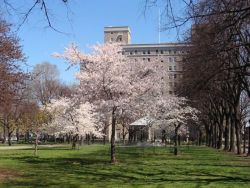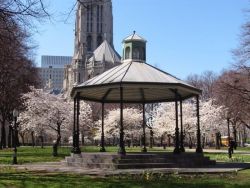Sakura Park
Sakura Park
Located between Riverside Church and International House, Sakura Park owes its name to the more than 2,000 cherry trees delivered to parks in New York City from Japan in 1912. The word sakura means “cherry blossom” in Japanese. The cherry trees were to be presented as a gift from the Committee of Japanese Residents of New York as part of the Hudson-Fulton Celebration in 1909.
This 18-day celebration, which commemorated the 100th anniversary of Robert Fulton’s innovative demonstration of the steam-powered boat on the Hudson River and the 300th anniversary of Henry Hudson’s discovery and exploration of that river, took place throughout the state of New York. However, the steamer that carried the original delivery of cherry trees from Japan was lost at sea. A new shipment of trees arrived in New York City in 1912 and were planted in Riverside and Sakura Parks.
Land for Sakura Park was purchased from John D. Rockefeller by the City of New York as an easterly extension of Riverside Park in 1896. Also known as Claremont Park, this land directly east of Grant’s Tomb featured rolling terrain with a curvilinear path system and benches facing the Hudson. With a donation from Mr. Rockefeller, the City hired Olmsted Brothers as landscape architects to redesign the park in 1932.
The two-year process included grading the site and laying formal paths to create rectangular plots of grass and shrubs, enclosed by hedges and fencing. A massive buttressed retaining wall, a reproduction of the wall surrounding Kenilworth Abbey in England, was built on the eastern border of the park along Claremont Avenue. The park was reopened to the public on May 25, 1934.
A monument to General Daniel Butterfield (1831-1901) was erected in 1918 in the southeast corner of Sakura Park. Sculpted by Gutzon Borglum (1867 – 1941), who also designed Mount Rushmore, the bronze Butterfield monument depicts the Civil War hero standing on a rock with his arms crossed and hat cocked. Butterfield, a Union soldier who rose to the rank of major-general and chief of staff of the Army of the Potomac, is best known for composing Taps, the melancholy bugle call performed during military funerals and memorial ceremonies.
A stone Japanese tori, or lantern, was donated to Sakura Park by the City of Tokyo and officially dedicated on October 10, 1960 with Crown Prince Akihito, later Emperor of Japan, and Princess Michiko in attendance. A common fixture in traditional Japanese gardens, this tori was made from native Japanese rock. Its inscription reads: “Presented by the citizens of the Metropolis of Tokyo to the citizens of the City of New York in celebration of the Tokyo-New York sister-city affiliation inaugurated on February 29th, 1960.” In 1987, the then Crown Prince and Princess personally re-dedicated the ten-foot tall lantern in a ceremony hosted by Mayor Edward I. Koch.
In 1981 the architectural firm of Quennell Rothschild Associates was engaged to renovate Sakura Park. The capital reconstruction included the installment of a play area for toddlers and plantings of linden trees, barberry shrubs, and several varieties of Japanese cherry trees. A pavilion, which is used as a performance space by the Manhattan School of Music, was also added to the park.
At the 1986 ribbon-cutting ceremony, Japanese Consul Hideo Nomoto stated: “In Japan, the sakura is a symbol of renewal and bright promise. The appearance of their fragile blossoms each spring strikes a resonant note in all Japanese. New Yorkers can enjoy cherry trees once again in Sakura Park, an island of calm on the hectic island of Manhattan.”
Check out your park's Vital Signs
Clean & Safe
Green & Resilient
Empowered & Engaged Users
Share your feedback or learn more about how this park is part of a
Vital Park System


